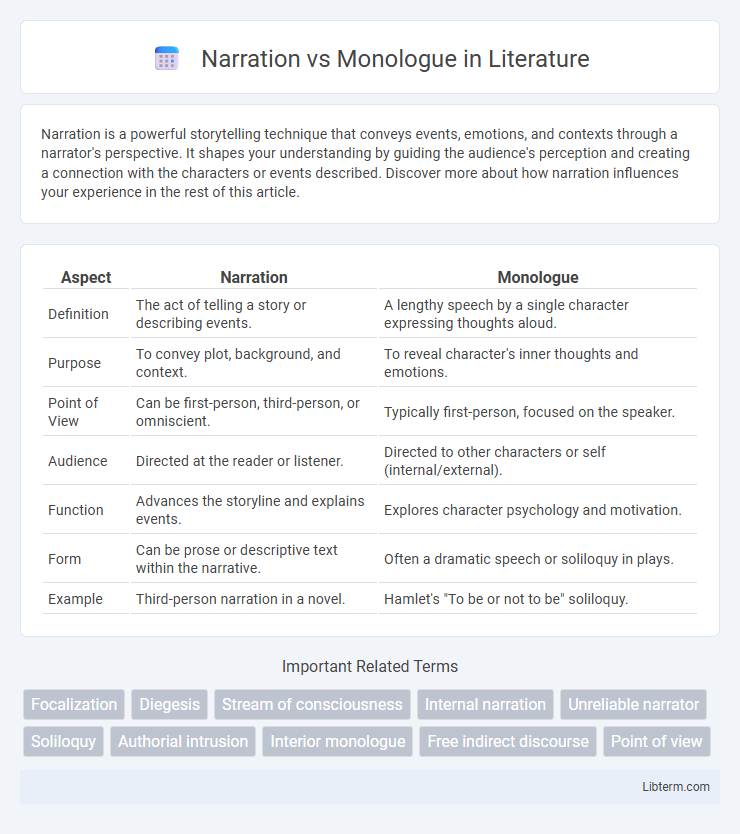Narration is a powerful storytelling technique that conveys events, emotions, and contexts through a narrator's perspective. It shapes your understanding by guiding the audience's perception and creating a connection with the characters or events described. Discover more about how narration influences your experience in the rest of this article.
Table of Comparison
| Aspect | Narration | Monologue |
|---|---|---|
| Definition | The act of telling a story or describing events. | A lengthy speech by a single character expressing thoughts aloud. |
| Purpose | To convey plot, background, and context. | To reveal character's inner thoughts and emotions. |
| Point of View | Can be first-person, third-person, or omniscient. | Typically first-person, focused on the speaker. |
| Audience | Directed at the reader or listener. | Directed to other characters or self (internal/external). |
| Function | Advances the storyline and explains events. | Explores character psychology and motivation. |
| Form | Can be prose or descriptive text within the narrative. | Often a dramatic speech or soliloquy in plays. |
| Example | Third-person narration in a novel. | Hamlet's "To be or not to be" soliloquy. |
Understanding Narration and Monologue
Narration involves a storyteller conveying events, often with a guiding voice that provides context, insights, and multiple perspectives within a narrative. Monologue features a single character expressing thoughts or emotions directly, offering deep introspection or revealing personal motivations without external commentary. Understanding narration versus monologue highlights how storytelling either shapes the audience's overall comprehension or immerses them in a character's internal experience.
Key Differences Between Narration and Monologue
Narration involves a storyteller providing context, background, and insight to advance the plot or explain events, often addressing the audience or reader directly. Monologue features a single character expressing inner thoughts or emotions aloud, typically revealing personal conflicts or motivations without external commentary. Narration offers an external perspective to guide understanding, while monologue delivers an intimate, subjective viewpoint from within the story.
Narrative Structure: Perspectives and Voices
Narration and monologue differ fundamentally in narrative structure, perspective, and voice. Narration typically employs an external or internal narrator who guides the story with a distinct narrative voice, offering multiple viewpoints and broader context. In contrast, a monologue presents a single character's uninterrupted speech, revealing inner thoughts and emotions from a singular, subjective perspective.
Monologue: Definition and Literary Significance
A monologue is a literary device where a single character speaks at length, revealing inner thoughts, emotions, or motivations without interruption. It serves as a powerful tool in drama and literature to provide deep psychological insight and advance the plot through the character's perspective. Unlike narration, which often offers an external overview, monologues immerse the audience directly into the character's personal experience and reflective dialogue.
Forms of Narration: First, Second, and Third Person
First-person narration offers an intimate perspective by using "I" or "we," allowing readers to experience the story through the narrator's eyes. Second-person narration addresses the reader directly with "you," creating an immersive and engaging experience. Third-person narration employs "he," "she," or "they," providing a broader and more objective view of the events and characters.
Types of Monologues: Interior vs Dramatic
Monologues are classified into two primary types: interior and dramatic, each serving distinct narrative purposes. Interior monologues reveal a character's internal thoughts and emotions, providing deep psychological insight and enhancing the reader's or viewer's understanding of the character's mindset. Dramatic monologues, in contrast, are spoken aloud to other characters or the audience, advancing the plot and highlighting character dynamics within the story.
Uses of Narration in Storytelling
Narration in storytelling serves to provide context, background information, and insight into characters' thoughts, enhancing the audience's understanding of the plot and setting. It guides the narrative flow by linking events and revealing motives, often bridging gaps between dialogue and action. Unlike monologue, which is a character's extended speech, narration offers an omniscient or limited perspective that shapes the overall story structure and emotional impact.
The Role of Monologues in Character Development
Monologues serve as a powerful tool for character development by revealing a character's inner thoughts, motivations, and emotional state directly to the audience. Unlike narration, which often provides external commentary or context, monologues offer intimate insight into the character's psyche, enriching the narrative with depth and complexity. This technique allows playwrights and screenwriters to explore themes of identity, conflict, and transformation through a character's personal voice.
Narration vs Monologue: Impact on Reader Engagement
Narration and monologue differ significantly in shaping reader engagement, with narration offering a broader perspective by providing context and multiple viewpoints that enrich the story's depth. Monologues create intense, personal connections by delving into a character's inner thoughts, fostering empathy and emotional investment. Narration guides the reader through the plot, while monologues invite introspection, both enhancing immersion through distinct narrative techniques.
Choosing Between Narration and Monologue in Writing
Choosing between narration and monologue in writing depends on the desired perspective and depth of character insight. Narration provides an external viewpoint, offering broader context and multiple character experiences, while monologue delivers intimate, unfiltered access to a single character's thoughts and emotions. Writers select narration for storytelling that requires objectivity and scope, whereas monologue enhances personal expression and emotional intensity.
Narration Infographic

 libterm.com
libterm.com